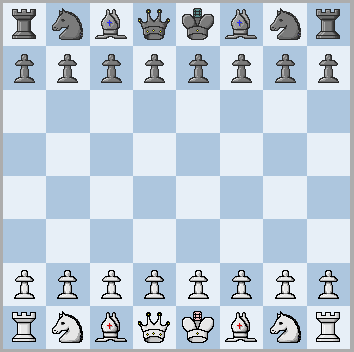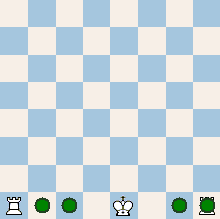

The only difference between Chess with Extended Castle and regular chess is the extended castle. When castling the king may jump three squares, but it can also jump two as usual. The rook ends up on its usual square. In Chess with Extended Castle, queenside castle will occur more often as this practically gains a tempo compared with standard chess, where the king nearly always moves again to the knight file. Certain opening systems might benefit from the extended castle, such as the King’s gambit, the Wienna Game, or the Dutch Defence. Especially, the queenside castle systems in the Sicilian would be improved.
 When castling the king can optionally jump three steps. The rook ends up on its usual place.
When castling the king can optionally jump three steps. The rook ends up on its usual place.
Discussion
I have studied much opening play, and I tend to get frustrated while it allows less and less room for creativity. Spassky felt the same about opening play. It always leads to a draw, so one could just as well play rapidly and pragmatically, instead of trying to be creative. He was thinking along such lines that fateful day when he declared that “this was my final King’s gambit” (after the draw against Ornstein). Opening play is today become a straightjacket. But wouldn’t it be fun to be able to play the Jänich gambit (in Ruy Lopez) as black? If tiny rule changes can infuse life into many opening systems, I see no reason why not to adopt it.
Obviously, if this little rule change could infuse new life into the King’s gambit, then chess would benefit greatly. Moreover, as classical games are fully compatible with the extended castle rule (one can still make classical castle), old master games are still relevant sources of study. Remember that there are obvious disadvantages with the long king jump. The king doesn’t defend the weak f2/f7 pawn, a cornered king runs a greater risk of mate, and the king is a longer way from the centre in the endgame.
There is a lopsidedness to today’s rules. In practice, queenside castle takes two moves, whereas kingside castle takes only one move. What’s the point in maintaining such an imparity? Why should kingside castle be favoured before queenside castle? Keep in mind that queenside castle is still harder to achieve while the queen must move away before castling. To move the queen early in the opening is controversial. Moreover, the queenside is a more dangerous place while the enemy queen is positioned there, and the enemy queenside pawns are more prone to pawn storms than the kingside pawns (i.e. it’s more dangerous to weaken the kingside pawn structure than to weaken the queenside).
But what would happen to the Sicilian Dragon? It would give white a tempo, which would probably prove disastrous for black, but only if black cannot make use of the kingside castle to the corner square. Nevertheless, this will not bring the Sicilian Dragon to its knees because black needn’t play the variation with 2...d6. He could play the 2...Nc6 system where white cannot castle on the queenside.
Moreover, many new Sicilian systems will become playable where white castles on the queenside, while black will avoid the Sicilian defenses that lead to a white advantage thanks to the extended castle. So the Sicilian will continue to live. Perhaps the Closed Sicilian will again rise to popularity, while white plays f4 in these systems.
• You can download my free Chess with Extended Castle program here, but you must own the software Zillions of Games to be able to run it (I recommend the download version).
• You can play Chess with Extended Castle online here.
• Don’t miss my other chess variants.
© Mats Winther July 2009